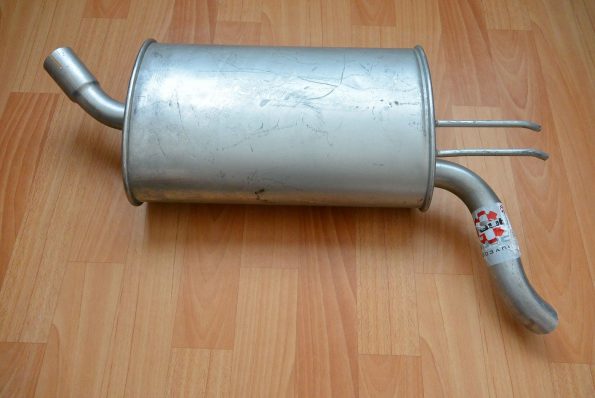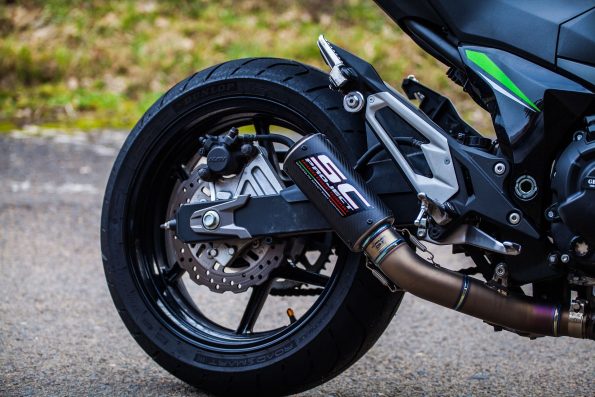What does a muffler do?
The muffler is a part of the exhaust which deadens the sound from the engine. You need one if you don’t want your neighbours to kill you because without it, your car will be very loud. Even a small crack in the muffler can make your car noticeably louder.

This is a car muffler not connected to an exhaust

This is a motorbike muffler attached to the exhaust
What happens if you remove your muffler?
As well as being extremely loud it’s possible that your car will lose some power. The engine requires some kind of back pressure to make it run efficiently. It is better to get a performance exhaust fitted which should liberate some extra power without making the car illegally loud.
Is it illegal to have no muffler on your car?
If your car was sold new with a muffler, it is likely that removing the muffler will contravene the rules set down in NSW legislation which can be found here. Bear in mind that other territories may have different rules (e.g. SA virtually renders it impossible to do anything other than minor cosmetic changes).
The maximum noise that a vehicle produced after 1983 is allowed to make is 90dB.
Legislation
Division 3 Motor vehicles with defective or modified noise control equipment
10 Sale of used vehicles with defective noise control equipment
A person must not sell a used motor vehicle if the motor vehicle has defective noise control equipment.
Maximum penalty: 100 penalty units in the case of a corporation or 50 penalty units in the case of an individual.
11 Driving or using vehicles with defective noise control equipment
A person must not cause or permit a motor vehicle that is not a heavy vehicle to be driven or used on a road or road related area if the motor vehicle has defective noise control equipment.
Maximum penalty: 100 penalty units in the case of a corporation or 50 penalty units in the case of an individual.
12 Modification or repair of vehicles causing noise control equipment to be defective
A person must not cause or permit a motor vehicle that is not a heavy vehicle to be modified or repaired so that the noise control equipment in the vehicle is defective. Maximum penalty: 100 penalty units in the case of a corporation or 50 penalty units in the case of an individual.
Use on roads of motor vehicles capable of emitting noise in excess of prescribed level
(1) A person must not cause or permit a motor vehicle to be used on a road or road related area if the motor vehicle is capable of emitting noise at a level in excess of the level specified in Schedule 1 for that type of motor vehicle as determined in accordance with Part 6 (the prescribed noise level).
Maximum penalty:
(a) if the vehicle is capable of emitting noise at a level that exceeds the prescribed noise level for that type of motor vehicle but does not exceed that prescribed noise level by 5 dB(A)—100 penalty units in the case of a corporation or 50 penalty units in the case of an individual, or
(b) if the vehicle is capable of emitting noise at a level that exceeds the prescribed noise level for that type of motor vehicle by 5 dB(A) but does not exceed that prescribed noise level by 15 dB(A)—150 penalty units in the case of a corporation or 75 penalty units in the case of an individual, or
(c) if the vehicle is capable of emitting noise at a level that exceeds the prescribed noise level for that type of motor vehicle by 15 dB(A) or more—300 penalty units in the case of a corporation or 150 penalty units in the case of an individual.
(2) A person is not guilty of an offence under this clause arising because the motor vehicle is being taken directly to a place:
(a) where repairs or other work required to reduce the noise level of the vehicle are to be carried out, or
(b) to be tested or inspected in accordance with a defective vehicle notice issued in respect of the motor vehicle, or
(c) to be tested or inspected in accordance with a notice issued in respect of the motor vehicle under section 207 of the Act, or is being taken directly from any such place to the place where the vehicle is usually kept.
(3) A person is not guilty of an offence under this clause in relation to the use of:
(a) a special purpose motor vehicle, or
(b) a heavy vehicle, or
(c) a motor vehicle being used on a road or road related area that is closed to traffic as part of a race, speed record attempt or speed trial approved by the Commissioner of Police under section 115 of the Road Transport Act 2013.
What are the fines for having a noisy car?
If EPA authorised officers are undertaking a campaign and pull over your vehicle with illegal noise control equipment, they may issue a fine on the spot. There is a tiered scale for fines – the louder the exhaust noise, the greater the penalty.
Under the POEO (Noise Control) Regulation 2017, on-the-spot fines can be issued for
- vehicle exhaust systems exceeding specified maximum noise levels
- vehicle engines being louder than when originally manufactured
- equipment on motor vehicles being defective or not securely in place
- offensive vehicle sound system noise
- motor vehicle intruder alarms sounding for longer than permitted times
- noise from vehicle refrigeration units being heard in homes at night
- offensive noise levels from motor vehicles used off-road being offensive
Maximum on-the-spot fines are
- $600 for an individual
- $1,200 for a corporation
The maximum court penalties that may be imposed when on-the-spot fines are transferred to court or are applied to repeat offenders are
- $16,500 for individuals
- $33,000 for corporations
Causes of excessive noise
Excessive noise is caused by
- the exhaust system having been replaced with a sports or other loud system
- the baffles having been altered or removed from the muffler
- defective noise control equipment in the exhaust system or engine making gas escape from a place other than the exhaust outlet
- noise control equipment having been fitted or modified to make more noise than the original equipment fitted by the vehicle manufacturer
- noise control equipment such as mufflers and baffles having been removed and not replaced
It is also an offence to use temporary noise reduction devices or packing in vehicle exhausts, including
- baffles in the exhaust system that have not been welded or riveted in place
- valves or other adjustable equipment
- materials inserted into the exhaust system, such as steel wool
However, the following equipment is permitted
- baffles that were not welded or riveted or an adjustable device in the exhaust system, or a replacement equivalent to that fitted by the manufacturer, when the vehicle was manufactured
- baffles bolted or otherwise securely fastened on a motorcycle
